Pfalz D.IIIa
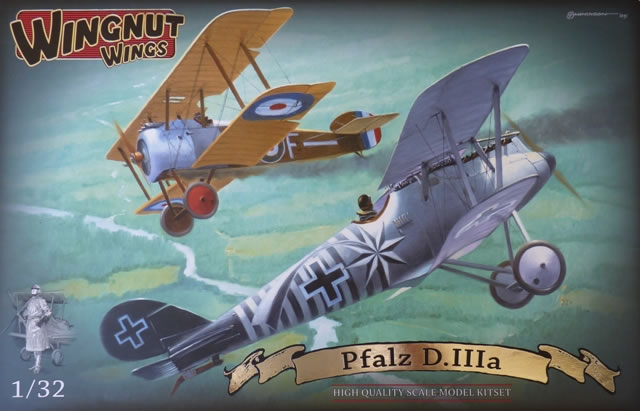
Wingnut Wings, 1/32 scale
S u m m a r y |
Catalogue Number: |
Wingnut Wings 32006 - Pfalz D.IIIa |
Scale: |
1/32 |
Contents and Media: |
149 parts in grey injection moulded plastic; two parts in clear; photo-etched fret; markings for five colourfully marked aircraft. |
Price: |
USD$65.00 - available online from Wingnut Wings.
Includes free international postage. |
Review Type: |
First Look |
Advantages: |
Cleverly engineered; outstanding representation of the surface detail; crisp clean mouldings; single piece wings with sharp trailing edges; comprehensive decal sheet in perfect register with minimal carrier film; inclusion of photo-etched parts; and an instruction booklet that doubles as reference material. |
Disadvantages: |
|
Conclusion: |
Undoubtedly this is the best representation of the attractive Pfalz fighter in any scale. This is a kit that has been designed for ease of assembly and it does so without compromising the high level of detail. The choice of “early” and “late” features within a single release is a credit to the manufacturer and allows the modeller greater flexibility with their choice of subject. With its simple strut arrangement and uncomplicated construction, this is an ideal kit for the first time modeller of WWI aircraft. |
Reviewed by Rob Baumgartner

HyperScale is proudly supported by Squadron
There is much to like about the Pfalz D.IIIa. Its elegant lines and colourful markings make it a perennial favourite amongst WWI aviation buffs.
Now it’s time for this aircraft to get the Wingnut Wings treatment and the wait has been worth it. The quality of past releases has been maintained and this is evident as soon as one opens the box.
Inside we find five plastic sprues which contain a total of 149 parts. There is minimal, if any, flash to contend with and the level of detail is outstanding. Despite the size of the major components, my example was free of any defects whatsoever. Naturally there are ejection pin marks as part of the manufacturing process but the design is such that these will be hidden on the finished product.
A choice of injection moulded windscreens is included and this allows a greater number of options to be portrayed.
Photo-etched parts add a bit more finesse to the model. These come in the form of machine gun jackets and the upper wing’s radiator shutter control. The former is also supplied in plastic should the modeller not be sufficiently experienced in manipulating metal.
This material also caters for the seat belts and is thin enough to allow for some flexibility when positioning them inside the cockpit.
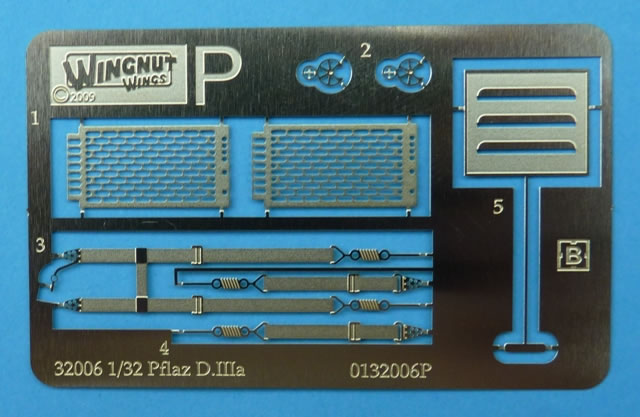
Two A4 sized sheets cover the decal options, and with 5 vastly different schemes, there is something to suit all tastes and skill levels.
One of the hallmarks of the WNW series is their ease of construction. Dry fitting the major components revealed no assembly problems whatsoever. The lower wing locates easily into the fuselage fairings and a clever join line away from the fillets’ razor edge guarantees that this detail will remain undamaged during the filling and sanding process.
In fact the fit throughout the kit is so precise that paint has to be removed from the mating surfaces to allow for the characteristic “click” of a successful bringing together of parts.
The cockpit is well appointed with no fewer than 26 plastic parts making up the “office”. This is positioned against the fuselage halves that have a scribed rendition of the ply shell on their inner surfaces. If you wish to detail your interior further, the instructions indicate the location of elevator, rudder, gun trigger, and throttle cables. Strangely WNW do not make the termination points clear for the latter two items. On the control column, the Bowden cables go to the left hand throttle grip and centrally to the machine gun trigger tabs.
The engine is no less impressive. Up to 24 parts can be used on the Daimler Benz D.IIIa 180PS engine and this fits perfectly onto the supplied bearers. This area is complete with structural members and even includes the often neglected oil tank.
Not much is seen in this cavity when the engine cowls are in place so if you want to add spark plug leads etc, don’t expect much of it to be visible.
The colour call-outs for WWI aircraft are always contentious and this is especially so for the Pfalz range of fighters. The reasoning given for Wingnut Wing’s choice of “grey-green” for the interior is entirely plausible, especially when one sees a particularly revealing period photograph in the instructions.
The wings are engineering masterpieces. Despite the size, they are perfectly moulded as single piece affairs. A faint representation of the stitching shows through the rib tapes, and trailing edges are sharp and well defined. The elevator, rudder, and ailerons are all separate parts so these can be animated to match the installed positions of the rudder bar and control column. The former features a lovely representation of the characteristic “washout” that’s so obvious on these aircraft and the moulded on actuators really help with the assembly process.
Speaking of the wings, there are two lower types that were fitted to the Pfalz D.IIIa. The earlier examples had pointed tips whereas those of the later pattern had a more rounded appearance. Both are supplied in the kit which further adds to the flexibility of this release.
The same applies to the struts as these also came in two styles. Initially the end brackets had a blunt look about them before evolving to the pointed shape seen on later aircraft. With all these permutations now available, the modeller has to be careful to follow the path that applies to their chosen subject. I must admit to cleaning up the wrong set of struts when starting my build!
Angled attachment points at the end of each strut ensure that these items get orientated correctly. The result is a top wing that aligns perfectly with the rest of the aircraft. One area that strikes fear into those not used to WWI aircraft is the undercarriage. A great model can be left wanting if the “sit” isn’t right. Fortunately nothing is left to chance here and the alignment is perfect.
The tailplane slots into the rear fuselage but it has a little more play in it than expected. It’s not a major drama and the small gap that results is easy enough to negotiate. The radiator is a drop-in fit and all fuel lines and other piping are thoughtfully supplied.
A comparison with respected scale drawings from a number of sources reveals no anomalies in the kit’s outline or detail. One area that did differ from some plans is the portrayal of the upper wing’s gravity fuel tank. This is usually drawn as being visible externally, a feature that can’t be seen in period photographs. Wingnut Wings has correctly modelled this as being concealed by the ply covering and have left only the filler cap exposed.
As we have seen already, there are plenty of extras supplied in the kit. Those not utilised will be very handy additions to the “spares box”. Niendorf, Wolff, and Axial propellers, a flare rack, rear vision mirror, and even an anemometer could all be candidates for future use depending on the aircraft chosen.
The instruction books are another highlight of the Wingnut Wings range. Not only do they clearly show where everything has to go, they also include plenty of reference shots. These come as either period photographs of the subjects themselves or of genuine museum parts that were once fitted to an airframe. The modeller is thus able to get a better feel for the subject they are building and increase their knowledge at the same time.
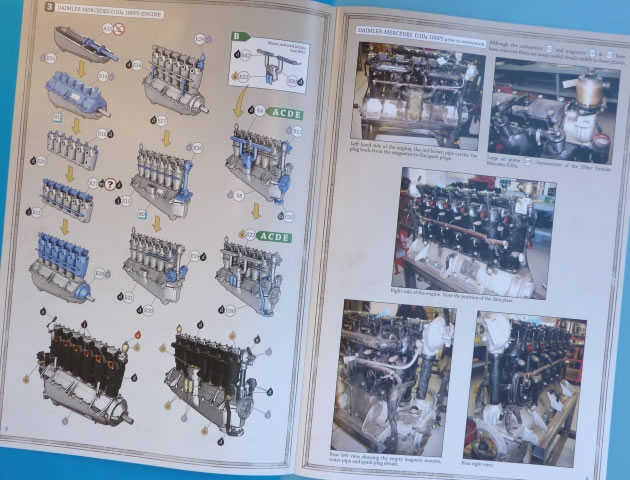
A full rigging diagram is included and in combination with the pre-drilled location holes in the kit, there is nothing left to the imagination.
Marking Options
Five aircraft are catered for on the well appointed decal sheets. Each is slightly larger than A4 and has been carefully printed by Cartograf in Italy.
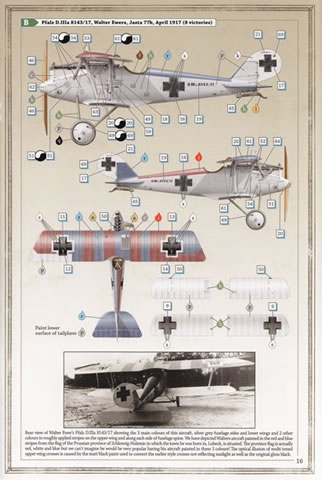
As such, the registration of each colour is perfect and the carrier film around each item has been kept to a minimum. A full complement of stencil data has been included and this extends to placards and propeller logos.

For the subjects that require it, bolts of 5-colour upper and lower “lozenge” are provided. To save the modeller from arduously having to cut rib tapes from this material, we get pre-cut examples in both upper and lower patterns.

The five marking options are:
- Pfalz D.IIIa 5983/17, flown by Hans Joachim Buddecke, Jasta 30 February 1918
Buddecke spent much of his time fighting in Turkey where he became the third airman to be awarded the Pour le Merite. After a brief return to the Western Front to lead Jasta 4, the ace returned to his original hunting ground to complete a second “tour of duty” and gained two more victories to bring his score to 12. The type of opposition he faced there didn’t prepare him for his subsequent return to France. He was shot down and killed by Sopwith Camels from No. 3 Naval Squadron only a few weeks later. His final tally was 13.
- Pfalz D.IIIa D.8143/17, flown by Walter Ewers, Jasta 77b, April 1917
Ewers scored his first 3 victories in 1917 while flying with Jasta 12. In January of the next year he was appointed Staffelfuhrer of Jasta 77b where he scored a further 5 times. With his total standing at 8, he was killed while flying Albatros D.Va 7220/17 on 15 May 1918 at the hands of 65 Squadron.
- Pfalz D.IIIa, serial unknown, flown by Max Hitschler, Jasta 18, late 1917.
Hitschler’s stay at Jasta 18 was a brief one. It lasted only 2 months before he transferred to Jasta 57 on 28 January 1918. He stayed there until the end of the war and didn’t trouble the scorers with any victories.
- Pfalz D.IIIa, serial unknown, flown by Max Holtzem, Jasta 16b, April - June 1918
This aircraft carries one of the more spectacular markings found on the Pfalz series of fighters. Note that this aircraft carried a non standard set of exhaust pipes, a fact that hasn’t escaped the vigilant eyes of Wingnut Wings. Holtzem served as a test pilot for Pfalz during much of the war and also found work as an instructor. He was posted to Jasta 16 and some sources record him with 2 victories. He survived the war and died in 1980 at the age of 87.
- Pfalz D.IIIa, serial unknown, flown by Hans Müller, Jasta 18 April 1918
Müller flew two-seaters before transferring to Jasta 12 in late 1917. In early 1918, he moved to Jasta 15, where he scored his first 2 confirmed victories. After the swap with Jasta 18 personnel, he scored his remaining successes with that unit and finished the war with a total of 12 successful combats.
The tradition continues with yet another stunning release from the Wingnut Wings stable.
The Pfalz D.IIIa was arguably one of the most aesthetically pleasing fighters to fly in the German Air Service. It wore an interesting variety of colours and markings and these attributes alone make it an ideal choice for a kit manufacturer.
When opening the box it’s clear that this is a quality product. The attention to detail is obvious throughout and the engineering of the kit allows even the most inexperienced WWI modeller to build an outstanding replica.
Undoubtedly, this is another worthy addition to the Wingnut Wings range of First World War aircraft.
Thanks to Wingnut Wings for the review sample.
Test Fit So Far...
Rob has already test fitted some of the major components of the model in advance of a full build. Here are some photos of his progress to date.
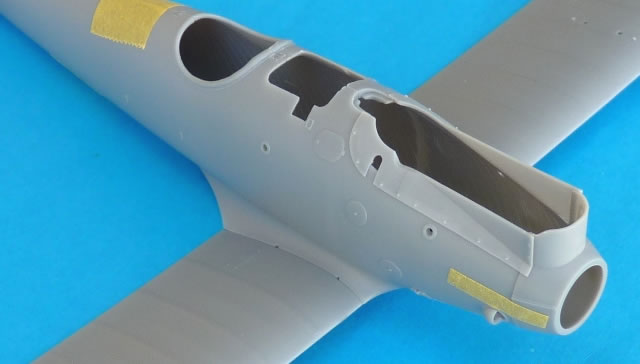
Note the outstanding fit and alingment between the fuselage anf lower wing parts.

Stay tuned for more!

Review Text and Images Copyright © 2010 by Rob Baumgartner
Page Created 20 January, 2011
Last updated
20 January, 2011
Back to HyperScale Main Page

|
